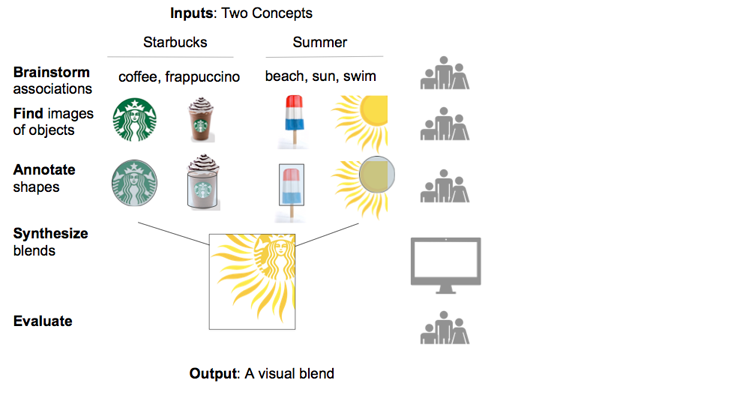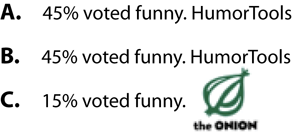Lydia Chilton on computational design: Combining human creativity with computation
![]() For the headline Liquid Water Found on Mars, which response is the least funny? Hint: One is professionally done, and two are crowdsourced. Voting results at end.
For the headline Liquid Water Found on Mars, which response is the least funny? Hint: One is professionally done, and two are crowdsourced. Voting results at end.

Creativity and computation are often thought to be incompatible: one open-ended and requiring imagination, originality of thought, and perhaps even a little magic; the other logical, linear, and broken down into concrete steps. But solving the hard problems of today in medicine, environmental science, biology, and software engineering will require both.

For Lydia Chilton, who joined the Computer Science department this fall, inventing new solutions is fundamentally about design. “When people start solving a problem, they often brainstorm over a broad range of possibilities,” says Chilton, whose research focuses on human-computer interaction and crowdsourcing. “Then there is a mysterious process by which those ideas are transformed into a solution. How can we break down this process into computational steps so that we can repeat them for new problems?” This question motivates her research into tools that are part human intelligence, part computer intelligence.
How this works in practice is illustrated by a pipeline she built to automatically generate visual metaphors, where two objects, similar in shape but having different conceptual associations, are blended to create something entirely new. It’s a juxtaposition of images and concepts intended to communicate a new idea, doing so in a way that grabs people’s attention by upending expectations.

Chilton decomposes the process of creating visual metaphors into a series of microtasks where people and machines collaborate by working on those microtasks they are good at. Defining the microtasks and the pipeline to make them flow together coherently is the major intellectual piece.
“The key is to identify the pieces you will need, and what relationships the pieces need to have to fit together. After you define it that way, it becomes a search problem.” Because it’s a search problem over conceptual spaces computers don’t fully understand, Chilton has people fill in the gaps and direct the search. People might examine the space of objects representing Starbucks and the space representing Summer, picking the most simple, meaningful, and iconic. The computer then searches for pairs of similarly shaped objects (as annotated by people), blending them together into an initial mockup of the visual metaphor. Humans come in at the last step to tweak the blend to be visually pleasing. At every stage in the pipeline, humans and computers work together based on their different strengths.
Crowdsourcing serves another purpose in Chilton’s research: harnessing many people’s intuitions. Foreshadowing her work on pipelines, Chilton created crowd algorithms that, more than simply aggregating uninformed opinions or intuitions, aggregate intuitions in intelligent ways to lead to correct solutions.
For example, deciphering this intentionally illegible handwriting would not be possible for any single person, but a crowd algorithm enables people to work towards a solution iteratively. People in the crowd suggest partial solutions, and then others, also in the crowd, vote on which partial solution seems like the right one to continue iterating. Those in later stages benefit from seeing contextual clues and thus build on the current solution, even if they wouldn’t have had those insights without seeing others’ partial solutions. “It’s an iterative algorithm that keeps improving on the partial solutions in every iteration until the problem is solved,” says Chilton.

Allowing people to collaborate in productive ways is the power of crowd algorithms and interactive pipelines. Her research into crowdsourcing and computational design has already earned her a Facebook Fellowship and a Brown Institute Grant. This year, she was named to the inaugural class of the ACM Future of Computing Academy.
At Columbia, she will continue applying interactive pipelines and computational design to new domains: authoring compelling arguments for ideas, finding ways to integrate existing knowledge of health and nutrition into people’s existing habits and routines, and creating humor, a known, very hard problem for computers because of the large amount of implicit communication and emotional impact.
“Although humor is valuable as a source of entertainment and clever observations about the world, humor is also a great problem to study because it is a microcosm of the fundamental process of creating novel and useful things. If we can figure out the mechanics of humor, and orchestrate it in an interactive pipeline, we would be even further towards the grand vision of computational design that could be applied to any domain.”
Humor is also a realm where human intelligence is still necessary. Computers lack the contextual clues and real world knowledge that enable people to know intuitively that a joke insulting McDonald’s or Justin Bieber is funny but one that insults refugees or clean air is not. As she did for visual metaphors, Chilton breaks down the humor creation process into microtasks that are distributed to humans and machines. This pipeline, HumorTools, was created to compete with The Onion. It generated two of the responses to the liquid water headline. The Onion writers wrote the third.
“I pick creative problems that involve images (like visual metaphors) and text (like humor) because I think both are fundamental to the human problem-solving ability,” says Chilton. “Sometimes a picture says 1000 words, and sometimes words lay out logic in ways that might be deceiving in images. The department here is strong in graphics and in speech and language processing, and I look forward to collaborating with both groups to build tools that enhance people’s problem-solving abilities.”
One of the people she will collaborate with is Steven Feiner, who directs the Computer Graphics and User Interfaces Lab. “It’s important to extend people’s capabilities, augmenting them through computation expressed as visualization,” says Feiner. “Here, the hybrid approaches between humans and computers that Lydia is exploring are especially important because these are difficult problems that we do not yet know how to do algorithmically.”
Chilton’s first class, to be taught this spring, will be User Interface Design (W4170).
Voting results for headline Liquid Water Found on Mars.

Posted 10/17/2017
– Linda Crane

